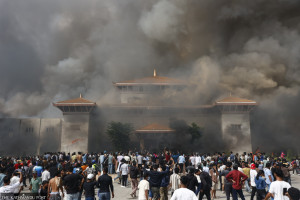Kathmandu
Mayor vows to start removing tangled wires and stray cables from tomorrow
Kathmandu metropolis accuses communication ministry of serving cable operators. Shah asked not to hold a grudge.
Anup Ojha
With the communication service providers reluctant to manage their tangled overhead cables and wires even as the Kathmandu Metropolitan City’s 15-day ultimatum soon expires, the City has declared a drive to remove all such cables and wires, starting Sunday.
Taking to social media, Balendra Shah, mayor of the KMC, also expressed his dissatisfaction at the lack of support from government ministries and the internet companies in his efforts.
Indicating that the City may unilaterally move ahead with its plan to remove the tangled cables, Shah informed the public that communication services may be interrupted in the days ahead in the course of the plan’s implementation. “You may be inconvenienced at times, but we are still expecting your support for this [drive],” Shah wrote on social media.
Shah planned to push ahead after the Ministry of Information and Communications didn’t cooperate with the municipal plan.
The ministry, in a letter sent to the Ministry of Federal Affairs and General Administration on April 25, said the consumers are deprived of communication services as “local authorities randomly cut cables in the name of beautifying the city".
It also argued that such random destruction of imported cables causes huge financial losses. KMC officials, however, say it was not a decision taken in haste.
“We had given an ultimatum, which ends on Sunday. After that, the KMC will start its drive to remove the jumbled wires,” said Surendra Bajagain, press coordinator of the mayor.
On April 24, the metropolis issued a public notice that it would proceed to remove the wires on its own if the internet service providers, cable TV service providers and other stakeholders did not comply with its request.
Talking to the Post, Bajagain said the City had requested all stakeholders to remove the jumbled wires in a coordinated manner.
“We didn’t issue this notice suddenly. The City had prioritised the removal of such wires since the day Shah was elected the mayor last year. But our request was repeatedly ignored,” he added.
Bajagain said there might be disruption of internet services for a few days and asked the people to be patient, since it’s a drive to keep the city clean and tidy.
Jumbled wires on the poles or stray cables lying on roads is a common sight in Kathmandu. Besides inconveniencing pedestrians, such wires and cables have added to the difficulty of persons with disabilities, children and the elderly, increasing their chances of getting into accidents.
“We were expecting the ministry’s help, but they seem more interested in working in favour of business operators. The City won’t hold back from what it needs to do,” said Bajagain.
Meanwhile, talking to the Post, Netra Subedi, spokesperson for the Ministry of Information and Communication, accused Shah of holding a grudge against the ministry.
“We are not averse to the City’s drive, but the ministry wants to properly handle such huge piles of cables. We don’t want to inconvenience people in any way,” said Subedi. “The KMC’s hasty decision will only invite more trouble.”
Subedi gave the example of Lalitpur Metropolitan City. “Lalitpur is now managing its cables in coordination with the internet service providers and other stakeholders,” said Subedi. "The KMC too could take a similar approach."
The jumbled wires have also increased the risk of fires. On his Facebook page, Mayor Shah has referred to fire incidents in Kathmandu in the past one year. He cited at least 53 fire incidents in Kathmandu because of unmanaged cables.
Officials at the KMC said they have already removed the jumbled wires in Thamel and Ason.
This is, however, not the first time the City has taken such an approach. After being elected as the Kathmandu mayor in May 2017, Bidya Sundar Shakya had also vowed to manage the jumbled wires on the utility poles—yet the problem remains unaddressed to this day.
Last year in November, even the Nepal Electricity Authority had issued a 45-day ultimatum to the service providers to remove messy cables in order to minimise accidents, including fires, and maintain the urban beauty, but the drive did not succeed.
Things are going to be different this time, say the NEA officials, because they have already put more than 65 percent of overhead low-tension electric cable lines into the underground cable networks.
But the City officials say the NEA drive is limited to areas along the main roads. In his conversation with the Post, KMC spokesperson Nabin Man Manandhar said the jumbled wires are more problematic in the narrow alleys and that the NEA had done little to manage them.




 7.12°C Kathmandu
7.12°C Kathmandu.jpg)











